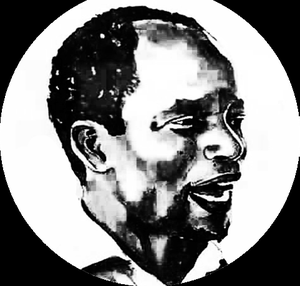
Man is the centre of the universe. His endless struggle for security and survival has created room for myths about life and death as well as other unforeseen circumstances that control his existence. These myths have resulted in practices in traditional African societies where the mask is believed to have magico-religious powers and can be used to ward off evil spirits. The traditional artist is thus motivated to create the appropriate mask to serve the desired functions in his society.
Frank A. O. Ugiomoh on the ‘Man, Mask and Myth’ project of Solomon Ona Irein Wangboje
SOLOMON ONA IREIN WANGBOJE’S MAN, MASK AND MYTH:
A DIEGESIS
A teacher affects eternity; he can never tell where his influence stops.
Henry Adams
Introduction
In 1964, Professor Solomon Irein Ona Wangboje began his career as an academic, and initiated a series in the printmaking medium he titled Man, Mask and Myth. This took him through three universities in Nigeria: Obafemi Awolowo University, Ile-Ife, 1968 – 1972, Ahmadu Bello University, Zaria, 1972 – 1978., and University of Benin, Benin City, 1978 – 1998., Through these years he produced seven compositions in the series (so far known), along with, other compositions that are analogous to the theme. The works in question are susceptible to reading in diegesis. Diegesis is central to reception aesthetics. Approaching a work of art in a diegetic encounter is a coming together of behaviours: the percipient with his or her history and the work of art with its history. Both histories encounter one another, with each, recognizing its specific role or activity at the perceptual level.
*
Wangboje incorporates the function of reception into the Man, Mask and Myth series as a narratological device: and the title appeals to the communication intention of the works, which are addressed to us in a reciprocally occluding connection. In other words, the figures the works embody relate to themselves as they dialogue with the percipient. So, a percipient is impressed upon to ask some questions such as, the signs that reinforce presence in the work? The quest would also include determining the social and historical background that propels the work into view and what it suggests or brings to mind? Put differently, how can one relate or respond to the works’ appeal? What constitutes the non-essential conditions of access to the works and their essential points of reception? The above would add up to the focus of the investigation in this essay.
*
To arrive at some understanding of the queries above I will move beyond the artwork Man, Mask and Myth as a symbol in an act of continuous construction from where Wangboje left off. To reconstitute a sign calls for a cognitive identification of such works with other signs that make them familiar. Therefore, I will draw on a variety of evidence as would be pertinent to the objective of this paper. The central concern remains to facilitate an epic encounter with the work as the theme Man, Mask and Myth suggest.
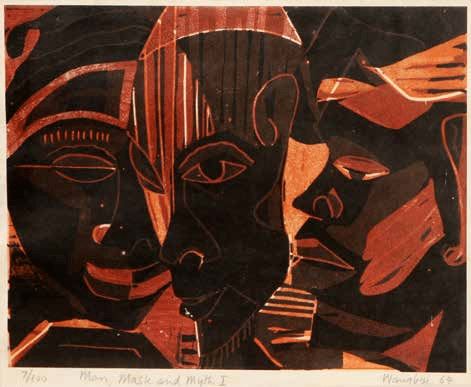
Man, Mask and Myth (fig. 1), 1964, Wanboje Gallery, Lagos
Formal Evaluation
Wangboje’s first work, in the Man, Mask and Myth (fig. 1) series, executed in 1964 in linocut print will be the central work that other compositions in the series will relate to. In figure 1, three figures are located on the main picture plane. These images are revealed essentially as portrait heads and their plane of relationship to a percipient and each other is in the profile perspective. In their relationship to themselves their directional focuses can be reduced to two significant orientations. From the left, there is a frontal encounter between the first two figures, and from the right, there is a co-ordinate of two figures confronting the right-oriented lone figure. The two extreme figures, within their relative positions to the central figure, equally, can be perceived as noggin at the central figure whose profile view is altered with a wide-awake frontal but focal gaze. The almost solid silhouette of this central figure impresses its form on the beholder.
Man, Mask and Myth IV
If we adopt the sequence in which the naming of this piece is conveyed the central figure whose background is in lighter hues stands out as the “Mask.” Its profile rendition does not associate them with the dominant formal characteristics that masks are generally known. In this regard, the three figures stand out as allegorical allusions to the theme of the print Man, Mask and Myth.
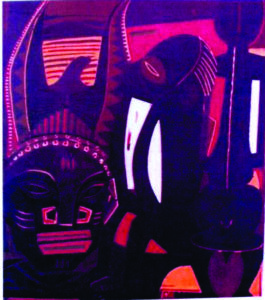
Man, Mask and Myth (fig. 2) 1978, Wangboje Gallery, Lagos
Description of Other Works in the Series
It will also be proper to describe how Wangboje represented the figures of man, mask and myth in the other series to determine how they relate to figure 1. Figures 2, 3 and 4 are consistent with the representational format of three figures each. In fig 2 and 3 especially, identifiable figures of masks are employed. In fig. 2, a Yoruba-like Gelede mask is the first from the left. This is followed by an arrangement of stylized African wooden sculptures, possibly ancestor images. The conventional focal attraction of the figure identified as mask in fig 1, is absent in the Gelede mask. Yet again, the central image in fig. 2 exhibits a frontally positioned eye in a profile-oriented image. In fig. 3, the first figure from the left of the viewing position is followed by a diminutive central figure that also focalizes among the images in the composition. Indeed, the print has two conventional masks, where the mask on the right surmounts another mask.
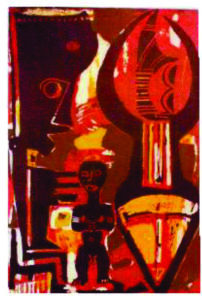
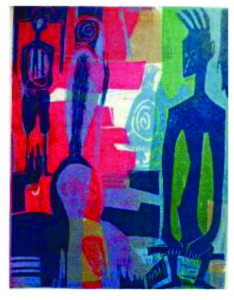
Man, Mask and Myth (fig. 3 en 4) 1978, Wangboje Gallery. Lagos
In these two compositions, the identifiable figures of a conventional mask do not gaze widely at the percipient as does the images in the middle of the compositions. Rather a reliquary figure of the Fang, in a diminutive status, plays the role of the focalizer in the middle of the two large figures that border it on either side. In fig.4 the central image is like a masquerade figure with other wooden figures flanking it on both sides. Figures 5 and 6 are related in their compositional structure. They are identified by their deviation from the dominant three-figure format as well as their frontal presentations of Bakota sculptures, which are usually placed over a package containing sample bones of outstanding and worthy ancestors as reliquary images. While fig. 5 belongs to the theme Man, Mask and Myth, fig. 6, only shares similar characteristics with it.
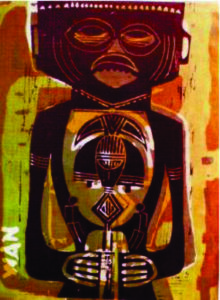
Man, Mask and Myth (Fig. 5) 1973, Wangboje Gallery, Lagos
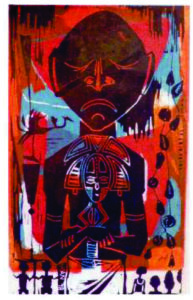
The Oracle wont lie (fig. 6) 1978, Wangboje Gallery, Lagos
In the arrangement format in these compositions, it is safe to deduce that all middle images stand for the connotation of the mask in the title. This inference is irrespective of the presence of conventional masks in the art works. But do these alternations hold any value for other likely assumptions? Can the regularity with which the figures relate to themselves as Man, Mask and Myth evoke a participatory consciousness or conventions of relationships in a societal structure? In the above giver order is there any presupposition regarding conventions in which human acts yield to experience in the sequence of the title? Or is there a way the artist has called attention to himself in these compositions within an evocative context? The above queries require a rise above mere identification of formal or figural relationships to engage in some wide-ranging discussions as a diegetic discourse demand. The value in such engagement allows for approximating the content of the form. Therefore, I begin by relating to the compositions from an epic consciousness in the first instance.
Epic Encounter
In figure 1, the image that represents the mask in the trilogy is strategic to the communication target of the composition. Its unblinking stare determines it as the focal point of events on the picture plane; the two figures flanking it on either side seem merely present, noggin at it towards self-projection, and the objective is played out with its location in the composition. Moreover, its frontally configured eye on a facial rendition in profile, which captures our attention beyond the other two figures is its trope. What then is achieved is the reality of an extreme interaction between it and any beholder that is immediately within its gaze.
*
The mask’s intense stare is its impact on the percipient. It assumes an invitation to participate in the drama, which it conjures. But the invitation harbours a paradox in its passive but strong and intent focus that is conveyed in an asymmetrical dialogue. It is an invitation to participate in a masquerading portrayal. Such invitation remains blind because the percipient is neither called to dance or to participate in the gyrations of a masked dancer. However, there is an allurement looking at the figures as composed to evade dialogue for contemplation. An option, usually with a bleak conversation, is to engage in another form of dialogue by a percipient on the metaphor of the mask.
*
What does one do in the presence of a masquerade, and what roles do these other figures of man and myth play in this “picture for pleasure?” As specie of the genera, man, is it possible that one is a component of an epic enactment of the man and mask symbolism? Another apprehension in an imaginary dialogue is the nature of commitment with meaning, the myth component of the composition. The two figures that border the central imagery on its left and right profiles identified as man and myth are detached; and their relationship with the beholder remains impersonal and without commitment. Is it then to be taken that they are hidden impetuses for the mask? Hence they seem to be nudging at the mask as a symbol. In these queries and derived impressions, a beholder, all the while comes to a sudden realization of engagement in a coerced relationship that has arisen from a forced attraction by a masked figure with an intense focal gaze simply!
*
The mask’s diegetic import is an allurement to participate in what it communicates. But the beholder still does not know this message and the print; Man, Mask and Myth as a constructed object is unable to tell its own story. The beholder has all the while confronted with an object of self-denial, which the mask is. The mask is neither aware of its role in calling attention to itself, through the perpetual attention it demands from its gaze. The beholder is once again called to evaluate the inner communications, which the three figures signify for themselves. What becomes apparent, as the theme of the work reveals, therefore, is that the interactive engagement of the three figures to themselves may be taken as the allegorical grounds for human actions, where an epic consciousness is awakened in the percipient.
Indeed, the above dialogue between the percipient and the composition has been asymmetrical. In such a dialogue, an eagerness to come to terms with what the art work communicates is met with a realization that the art work is only an object designed to be hung on the wall, a picture for pleasure. Any of the graphic prints, therefore, within a communication intent could be any object whose identity is not known to it. Thus, as Hamacher would have it:
The language of the epic, the first language of art-religion and the first language of art is thus the language of self-dementia in which actual subjects go astray in a futile play with no result and no issue, and in which substance as a superfluous and therefore a ridiculous dobbing, cannot cease ending up in comic conflicts with itself. (1)
*
What the mask figures represent, therefore, from a supplementary meaning, is hinged on an allegory. (2) With such frontally balanced pictorial compositions, which eliminate perspective depths, a lingering confrontation with the figures in the dialogue they initiate remains sustained.
In masquerading enactments, the epic context implicates an arena, and a crowd participating in an unfolding dialogue. But these have been reduced to signifiers of such a reality in art works meant for wall decoration or to be part of a collector’s repertoire. The compositions are not about actual masks or the myths that actual masks embody. Rather “man as the measure of all things” represents himself and one of the products of his imagination; the mask and the allusions vestigial to it.

Bruce Onobrakpeya
The Context of Masks and Masquerading
Masks and masquerading themes feature in much of contemporary Nigerian prints and paintings. In Sahelian Masquerades, (3) Bruce Onobrakpeya, Wangboje’s contemporary in Nigeria, introduces his work between 1985 and 1988. Its central theme is encapsulated in the Urhobo language thus Egbe Ghine Ugwu (translated as the dance of defiance). (4) About the theme, Onobrakpeya says it is a fall back to “art, religion, music, and dance to help the people “go through the hard times.”
In Onobrakpeya’s terms, we are drawn to one of the contexts in which the mask is appreciated among the Urhobo. In Trowel’s three-plane categorization of African art, viz., – man-regarding art, spirit-regarding-art, and art of ritual display, we find a variety of contexts in which the mask functions in Africa. (5) Masquerading cultures still constitute the dominant social institutions in Nigerian society. They function within a continuum of rituals, social relationships, and entertainment. They have also remained agents of great social change in many African communities.
The context of the mask as an art work points to an allegory where myth resides. The first of these is the masquerade’s claim to anonymity. “I am not myself.” (6) Within medieval consciousness, myths possess a reality of their own. The reality of the myth, however, is not to be taken as a measure of its objectivity. Cosopor and Daniels observe that, with myths, and by their nature, standing over and against each other as they do, the unidirectional notions of cause and effects for which myths are known, result in contrary theories of knowledge typified as projectionist and revelationist. The projectionist concept relates to generated ideas projected on the external world and the revelationist amounts to theological assertions on the revealed essences of life. (7) In the medieval conception, therefore, myths had the consummate authority of their own as codified knowledge. But the problem with the type of knowledge, which myth makes available, is illusory. With such knowledge, humans can neither master their environment nor understand the universe. (8)
Wangboje’s myth derives directly from a symbol, which is the mask, a product of the human’s epic consciousness. And this is how his work will be evaluated despite his opinion about the mask, which is foregrounded in the medieval conceptions of myth. I relate with his explanation of the theme in focus Man, Mask and Myth in 1992.
Man is the centre of the Universe, the hub around which most of our activities revolve. His preoccupation with the basic necessities of life including security and survival has given rise to myth built around him. These myths have in themselves provided the inspiration and motivation for artistic expression. The mask, being a work so inspired, and which is made to serve several purposes in African societies, is a physical and spiritual manifestation of man’s struggle to grapple with and overcome the problems of his environment. (9)
The mask, as to form, is a physical manifestation of an idea. The mask as a symbol also is foregrounded in a context that lends credence to its history. Masks, as symbols, demand attention. And this is inferred from the way Wangboje has employed them as focalizers in his compositions. We will, therefore, appropriate them as aids whereby humanity can come to terms with concepts that are within the domain of the sublime.
Conceptual Frame of the Mask in the Modern
The mask, as a physical object, depends on the creative capacity of humans for it to assume a cognitive form. Thus, Wangboje’s allusion to mask and myth is further evaluated here in the direction of Hinks, who says that “mythical representations with allegorical explanations made its appearance in iconographical interpretation in the post-medieval era as in literary criticism,” to help in the construction of historical meaning. (10)

Hannah Arendt
Hannah Arendt provides the context masks can be related to beyond their physical manifestations. The allegory of the mask owes some ancient origin in the Latin word “persona.” The word “persona” signified the mask actors wore in ancient times during acting. It is the origin of the concept, “dramatis personae.” (11) In other words, the mask stands as a metaphor; shielding the identity of the actor as well as his countenance, but, allowed his voice to be heard. As a language of the theatre (acting) it bears a strong relationship to the masquerade understood as a shielded identity. The mask’s evocative context remains simply “I am not myself.”
As Arendt further explains it, the word “persona” assumed a political relevance with the distinction created in Roman law between the “private individual” vis a vis the “Roman citizen.” The abounding implication of the citizen against the private individual is explained as follows:
A Roman citizen – had a Persona, a legal personality as we would say; it was as though the law had affixed to him the part he was expected to play in the public scene, with the provision, however, that his own voice would be able to sound through…without his persona, there would be an individual without rights and duties, perhaps a ‘natural man’ that is…. indicating someone outside the range of the law and body politic of citizens, as for instance a slave – but certainly a politically irrelevant being.(12)
*
Towards the end of the term of Wangboje from active teaching at the University of Benin, Benin City, he responded to an inquirer on his achievements thus: “Now that we are no longer anonymous let us see what we have done.” (13) I appropriate this response, even as a Freudian slip, in the context in which Arendt explains the origin of the word “persona.” It is that Wangboje was well aware that he was a “legal personality” with all its connotations. It is interesting to note that the theme Man, Mask and Myth was fashioned the year Wangboje started his career as a lecturer. Central to the essence of this theme is an associative role the mask, which invests him with “legal rights” to function on behalf of a constituted authority, which is the government to teach its citizens. In the context of Man, Mask and Myth, therefore, it could be assumed that Wangboje locates himself as an identity with the genus man, but by representation his personality now constitutes a “mask” – a “persona”, who, under anonymity served in an institutional setting as a teacher in a university. The above reading implicit in the reconstitution the Wangboje “persona” commutes to a synecdoche.

The Road is Long, 1982
Wangboje’s last thirty years were spent as an active professor and an artist. The implications of these two engagements are such that place a high demand on the individual. There is a way it would appear that the vocation to be an artist, as well as a teacher, constitutes a strain. This is because both engagements (teaching and art-making) at root embody ideal quests for knowledge. They engender the initiative to perceive, to search, and to know. To perceive and to come to terms with what is perceived, in terms of knowledge, fosters the zeal to communicate. The ability to communicate adequately demands prudence. With the above endowments, Wangboje constantly approached remarkably high ideals in the transcendental truth both engagements deal in. (14) He knew also that the limits of the possible as an artist and a teacher were in constant shift. The conquest of any aspiration to know only engendered further quests for knowledge. His aspiration as a teacher was to constantly strive toward that knowledge even in its arduousness. He vividly expressed this sentiment in one of his compositions entitled The Road is Long (1982).
*
After thirteen years break, I returned to active studio at the age of sixty-two years. The Road is long can be regarded as a self-portrait. In its universal application, The Road is Long is a journey through life; as the journey progresses, the shadow lengthens, the road is lonely, the responsibilities become larger and heavier. The traveler who eventually makes it to the end is usually the one who is determined, dogged and purposeful. The Road is Long is a lesson in endurance and determination. (15)
I had observed with special reference to the concluding sections of the above quotation as follows
There is a way in which it could indeed be said that the demands on Wangboje’s talents far outstripped the energy with which he was endowed. As a mortal, he did not achieve all that constituted his dreams. Like so many ambitious artists and intellectuals he had dreams and ideas that could accommodate another forty years. The reality of his person and achievement are tangible, but with time, will they be over-laid with some mythical fervour as a legend? Like a mask, he engineered phenomena of great social and cultural contexts. The roll call is diverse, breathtaking and monumental in the future definition of Africa’s iconographic landscape. (16)
*
Concerning Wangboje’s genius and achievements as an artist and a teacher, Sule Bello had this to say
The entry of Professor Solomon Ona Irein Wangboje into the vocation of art and art education has no doubt set a landmark in the annals of history. Professor Wangboje’s approach to art education has continuously enjoyed an immeasurable latitude considered by keen scholars as diversification of both the transcendent and the empirical, a mixed grill of the fragments of experimentation, improvisation and innovation. This liberalist disposition of Wangboje has not only influenced the patterning of the Benin school, during his long sojourn thereafter his monumental contributions at O.A.U. then the University of Ife, Ile Ife, and A.B.U., Zaria, but has equally permeated osmotically through the individuals who were lucky enough to enjoy his tutelage and generosity. (17)
*
The above comments on Wangboje are in sync with the rationale that earned him the USEA award in 1988. On that occasion, Wangboje commented that he never knew that he was being watched. (18) The source of Wangboje’s transcendence as these few clips on him show lies in his commitment to his calling as a professor and an artist. That he never knew that he was being watched underscores the commitment with which he confronted tasks. In the Yoruba phenomenology of creativity, a performing artist(e) engrossed in an enactment or creative process is oblivious of the fact that he is being watched (Eni ti a nwo Kii nwo iran – the one we have come to look does not look). In Steinberg, the artist has his audience, and since an enactor cannot be his audience, it is the place of his audience to evaluate his conduct and artistry. (19)
*
Having regard for the evaluation so far I locate Wangboje in the metaphor Man, Mask and Myth series, which he created. The supplanting of Wangboje in the sign he generated in his artworks is to neutralize the artwork as a sign. In the context, it opens an avenue for a historical location of the works. Thus, Wangboje as an embodiment of Man, Mask and Myth enacted metaphors of great social contexts. The realization of his role as a “persona” that had become unmasked at retirement brought him to the evaluation of self thusly; “Now that we are no longer anonymous let us see what we have done.”
*
To have arrived at the above conclusion is not to be regarded as embracing reductionism, or canvassing a metonymic location of Wangboje. No. Strother’s study of an extant masquerading culture in the Democratic Republic of Congo instructs on the phenomenon of the mask, with which Wangboje has been identified. The masquerade, as an ‘accumulative sculpture’, is an art work. Its effectiveness is consequent upon collective memory and consciousness. Beyond the act of a mask’s initial invention, it is in constant reinvention. The masquerade, as a product of collective consciousness, fosters a dialectic of conventions that allow for further inventions. In the sense of history, reinventions are internalized within the framework of time and space perception of experience. To reinvent a masquerade involves the resetting of a masquerade’s costume or the retooling of its structure. What is implied here is the act of continuous re-evaluations of a mask as art work, and it makes for its relevance in any milieu that hosts it. (20) Strother also established that the emergence of masks is not indeed mysterious and therefore, does not call for imaginative constructs such as the projectionist or revelatory cover in which the medieval myth operated. (21) Wangboje, in this regard, as man can be seen as locating the self in the genus, and as an individual, he identifies with the genera – man participating in epic enactments. Hamacher evaluating Hegel in his famous proclamation on “the end of art” hints on the above anonymity of the tragic in the actions of humans.
*
Whereas the “dispersion of the whole” is completed in the pantheon of epic language and in the dissolution of the subject into contingent and inherently external personality, the higher language, the tragedy, organizes the dispersed moments of the substantial and, effective world into two opposing groups: into the agents of dramatic action and, opposed to them, the instances of their unknown substantial laws. These latter are no longer, as was still the case in the epic, the objects or contents of a narration recited diegetically by another voice: rather they present themselves in their own words. (22)
Wangboje’s call, I emphasize again, as he moved beyond the epic phenomenon as “persona”, calls on us to evaluate what “we (he in union with institutional authority) have done.” This is where, then, the mask, as a tragic essence, is reconfigured as it assumes its proper identity as a product of a culture with life beyond its previous premise. The focus then is to semantically neutralize what Wangboje has presented to us as art work. It is the reason Harmacher observes that of the two opposing groups that are affected by the action of the ‘mask’ one narrates and the other translates in simultaneity. The result is a comic relief, which allows for multiple voicing that attempts to translate the work of art as a cultural text. (23) The interventions of multiple voices in an art work remain aestheticized notions, and they constitute yet other art works in themselves. This is why Barnett evaluating Hamacher’s treatment of Hegel’s notion of the end of art in The Phenomenology of Mind says that,
These unknown laws are embodied as gods, like masks of an abstract substantiality. Tragedy thereby stages the impossibility of consciousness to know itself. [Hence the persona as presented to the public]. The function of comedy is to play with these masks. Comedy becomes how the subject plays with itself as other in that it plays with itself as the appearance of abstract substantiality – as, in short, a mask. In comedy, there are no substantial forms, only desubstantialization that deforms everything that could be its object. The subject eventually triumphs, however, over substance, retaining masks as trophies of his victory. Yet this victory is Pyrrhic, for the self has triumphed only over its own substance. (24)
*
The rationalization above is where Man, Mask and Myth, as a dialectic, finds apt logic. Here, the mask’s metaphoric essence becomes a gatehouse that privilege actions of men in epic realities. The quest to come to terms with the “mask” as a tragic essence results in “myth” as “comedy” where new actions are forever triggered. In other words, comedy as interpretations or interventions that aspire to aid meaning constitutes an autonomous voice. Comedy, therefore, constitutes another end: In the trilogy Man, Mask and Myth as dialectic, the sequence of these relationships would be that each new action carries with it the reality of an end, each end is a death and each death is only another beginning. Myth becomes the intervention that fosters a continuity that opens the channels of communication. Myth becomes that constant “desubstantialization that deforms everything that is its object.” The above translation is offered by Wangboje in a later re-evaluation of Man, Mask and Myth.
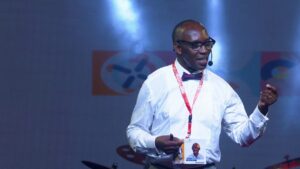
Frank Ugiomou, the writer of this essay
Man is the centre of the universe. His endless struggle for security and survival has created room for myths about life and death as well as other unforeseen circumstances that control his existence. These myths have resulted in practices in traditional African societies where the mask is believed to have magico-religious powers and can be used to ward off evil spirits. The traditional artist is thus motivated to create the appropriate mask to serve the desired functions in his society. Hence the trio of Man, Mask and Myth as a series in my work since 1968 as a reminder that in the midst of life, we are in death. (25)
By the above, Wangboje reminds us that the mask will always be with us and probably as trophies. If we read Henry Adams rightly, the end of the reading of Wangboje will continue to hold on.
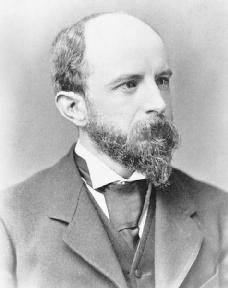
Henry Adams
Conclusion
The art work, Man, Mask and Myth, the agenda of this paper, is subsumed in an epic encounter influenced by the narratological device employed by Wangboje in the series. Wangboje and his role as “persona” in an institutionalized setting are supplanted in a semantically neutralized context in the mask he created. Hence in this trilogy of an epic representation the forms of mask and myth transform into tragic and comic elements in the composition. Any effort to come to terms with their reality by way of interpretations as this paper set out to do will end up in replicating other masks. The aestheticised origins of these replications of masks compound the semantic circle and labours to arrive at meaning.26 The merit in attempts of this nature, however, is the way interpretations contribute to the quest to understand the product of culture. Even where there is a mismatch between a semic code and an ascribed syntactic allusion to meaning, that reading does not mark an end. To be sure, other readings would emerge concerning Wangboje’s work. In line with the focus of this paper, other masks that relate to the work Man, Mask and Myth will continue to pile up as trophies to be protected for posterity.
End Notes
1. W. Hamacher, “The End of Art with the Mask,” in Hegel After Derrida, ed. S. Barnett, London: Routledge, 1998, p 108.
2. In Medieval Africa, the masquerade as an idea is subsumed in the concept “mask” since it was part of its costume. Among the Owan people in (Ora clan of Northwest Edo) where Wangboje belonged the word erimhi is used for masquerade as a generic term. The word equates the masquerade with spirits from the non-human world. Thus, the identity of the masquerade is synonymous with that of the spirit, which the word erimhi stands for. The supplanting of mask for the masquerade in modern Africa is a product of acculturation. Thus, what the mask is referred to here its conception should imply a reference to a masquerade.
3. Bruce Onobrakpeya, Sahelian Masquerades, ed. Safy Quel, Lagos: Ovuomaroro Gallery, 1988.
4. Ibid, p 3.
5. M. Trowell, Classical African Sculpture, London: Faber & Faber 1970, Pp 25 – 39. The mask alone as a headpiece in an African context would function as a torso without a head or limbs. References to the mask indeed imply the masquerade. In this regard, Wangboje produced supportive works that lend credence to this understanding, in such works as “Dance of the Masquerade”
6. Z. S. Strother, “Invention and Reinvention in the Traditional Arts” African Arts, Vol. 28 No 2. (1995)
7. O. Cosopore and O. Daniels, Iconography of Landscapes, Cambridge: University Press 1988, p 33.
8. C. Levi-Straus, Myth and Meaning London: Routledge 1980, p 17.
9. S. I. Wangboje, “Note on My works” 1992 2nd November. It contains explanations on the following works by Wangboje the Eye, the Road is Long. II, Dance of the Masquerade II, Earth Moon and Sky, Conversation of Four and Man Mask and Myth.
10. Jan BialostockI, “Iconography,” in A Dictionary of the History of Ideas 4 Vols. N.Y.: Charles Seribriers and Sons 19732,525.
11. Arendt. On Revolution, Harmondsworth Penguin Books 1965, p 106.
12. Ibid. p 107. Cf. Gilles Deleuze, Cinema I The Movement-Image Trans. H. Tomlinson & B. Habbers Minneapolis: University of Minnesota. 1986, also touches on the idea of the conceptual persona and the “aesthetic figure” as generated images.
13. F. Ugiomoh, “The Man the Mask and the Myth” in AwanSCA The Man, the Mask and the Myth: The celebration of A Legend,” Exhibition Catalogue, Lagos AwanSCA, 1998, p1.
14. Ibid, p 9.
15. S. I. Wangboje, op.cit.
16. Ugiomoh, op. cit. pp 9 – 10.
17. Bello, S: “Forward” Op. Cit. p 2.
18. S. I. Wangboje, 1988 Ziegfeld International Award Reminiscence: 30 years on the road. Exhibition Catalogue, Lagos: Wangboje Art Gallery 1996.
19. L. Steinberg, Other Criteria London: Oxford University Press 1972, pp3- 4.
20. Strother, Ibid, pp 24 – 33, 90.
21. Ibid.
22. W.Hamarcher, Ibid, p 109.
23. For Steinberg, ibid p. 4, the art work is a presentation to an artist’s “public”. It is to this same public that Wanbgoje refers to when he calls for his evaluation. An artist’s public “refers to a role played by people before an enactment or unfolding experience.” Only those who are beyond experience should be exempt from the charge of belonging to the public.” This conception illuminates on Harmacher’s enunciation of moving beyond the epic consciousness where a percipient or a participator in a collective action is expected to move beyond experience to affirm knowledge, by making such knowledge available in his/her “own words.” To move beyond experience is to provide a fruitful reading of the content of an experience that an art work embodies.
24. S. Barnett, “Introduction: Hegel before Derrida,” op.cit. p 30.
25. Wangboje, op. cit. p 11. This version is a 1995 redefinition of the creative motive of “Man Mask and Myth.” If the 1992 explanation by Wangboje taken together with this “that in the midst of life, we are in death” we are reminded of Bernett’s conclusion, which note 23, refers especially to the highlighted emphasis.
26. M. A. Holy, “Patterns in the Shadows” Invisible Culture Online (http//www. rochester.edu/ in_vissible_culture /issue/holly/holly.htm/1 1999)
Frank A. O. Ugiomoh is a professor of History of Art and theory and previously he occupied the Yemisi Shyllon professorial chair in Fine Art and Design at the
